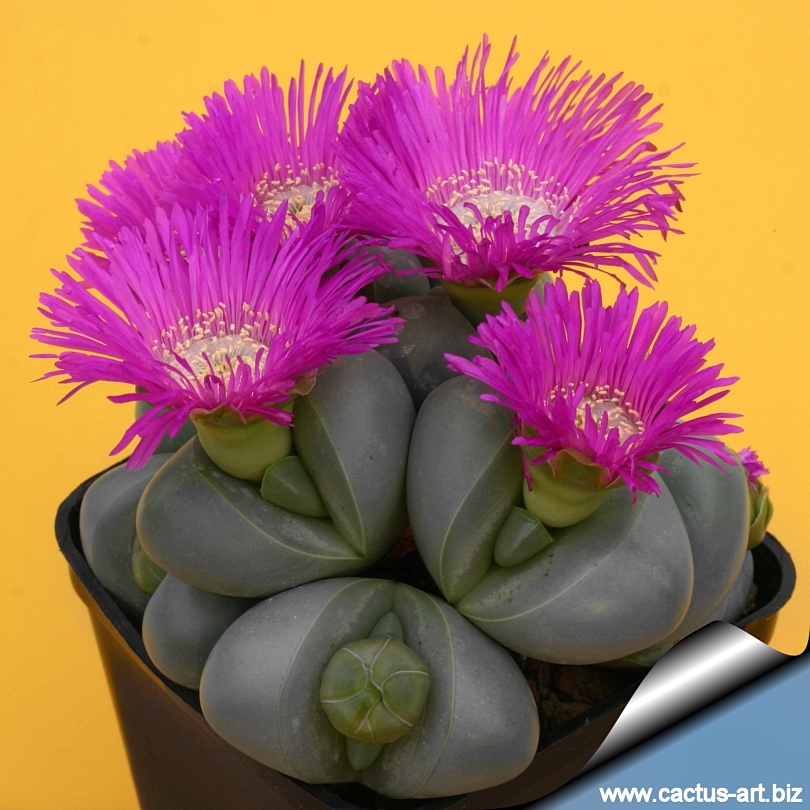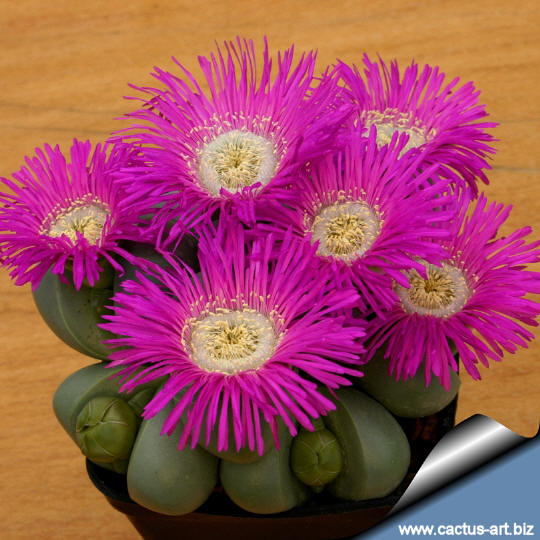|
|
|

Argyroderma delaetii resemble little eggs made out of
quartz or jade.
The flower are large daisy like. The color is quite variable in this
species,
even in the same population: purple, pink, violet, and white are
the most common,
but Argyroderma delaetii also exists in several shades of yellow - you
never know.
|
|
These succulent plants are popular
among cacti and succulent plant growers, although rather rare in
collections in spite of being very interesting plant for their unique
shapes and colourful flowers. What appeals to most people is the fact
that the plants will often resembles chubby, quartz egg-shaped pebbles
with a silvery sheen of the land they are native too. The plants evolved
to look like stones in order to evade detection and consumption by
animals.
|
|
Description: Argyroderma
delaetii remain solitary or slowly clump and form clusters of little
“eggs” at the ends of short prostrate stems, They consist of a pair of
fleshy leaves, either in clusters or singly, up to 3 cm high.
Body (Leaves): Silvery-blue to blue-green eggs-shaped cut almost in two
along their width, with a v-shaped fissure extending along the cut. Each
half of the cut open egg is actually a greatly thickened leaf, and each
year a new set of leaves appears in the fissure, arranged
perpendicularly to the preceding pair of leaves.
Flowers: Proportionately large and red-purple, yellow or rarely
white, also emerge out of the central fissure.
Flower: The flower are large daisy like from the junction. The
color is quite variable in this species, even in the same population.
purple, pink, violet, and white are the most common, but Argyroderma
delaetii also exists in several shades of yellow - you never know.
Blooming season: Flowers appear late in autumn.
Cultivation: Argyroderma is easy to grow. These plants grow on
winter rain and were heading for summer dormancy. Requires little water
otherwise its epidermis breaks (resulting in unsightly scars). Water
minimally in summer, only when the plant starts shriveling. Requires
good drainage. Keep cool and shaded in summer, need full sun or light
shade.
|
|


Advertising
|
|
|
|
|
Family: Mesebrianthemaceae (Aizoaceae)
Scientific name: Argyroderma
delaetii Maass
Origin: South Africa (Knersvlakte, Little Namaqualand)
Habitat: Grows in one of the most
strange ecozones on Earth, the quartz fields of coastal Namaqualand in
northwest South Africa . This region consists of flat plains or gently
rolling hills - that seem to just go on for miles in every
direction - completely covered with small (2 cm to fist size) chunks of
white quartz atop rocky, saline soil. Hidden among the the pure white
quartzite or clustering on top of them argyrodermas make their yearly
set of leaves, flower and set seed. And their reproductive abilities are
impressive. In a good year, with enough winter rain to supplement the
frequent fog that keeps the whole ecosystem surviving, some quartz
patches are so dense with Argyroderma that the ground is blue with them
rather than white and it's impossible to walk (even on tip-toe) without
stepping on them. Some plant in habitat have scars or burst in their
skins, just like they do at home.
Conservation status: Listed in
CITES appendix 2.
Common Names include: Living rocks, Stone Plants, Egg
plants.
Etymology: The name "Argyroderma" means
silver skin.
|
Heterotypic synonyms:
- Argyroderma speciosum,
- Argyroderma leucanthum,
- Argyroderma longipes,
- Argyroderma splendens,
- Argyroderma planum,
- Argyroderma lesliei,
- Argyroderma productum,
- Argyroderma reniforme,
- Argyroderma schuldtii,
- Argyroderma brevitubum,
- Argyroderma roseum,
- Argyroderma aureum,
- Argyroderma concinnum,
- Argyroderma australe,
- Argyroderma blandum,
- Argyroderma boreale,
- Argyroderma citrinum,
- Argyroderma densipetalum,
- Argyroderma formosum,
- Argyroderma gregarium,
- Argyroderma latifolium
|
|
|
|

|
|